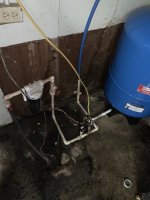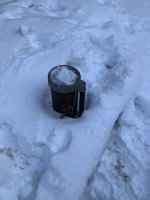1. EDIT I
had presumed the water from the well was coming via that blue pipe. There should not be a valve between the well and the pressure switch, so be sure to not close that valve. You should not have a cartridge filter between the well and the pressure switch either. I presume the pump delivers significant GPM at low pressure. A clogged filter would slow the flow but would not affect the maximum pressure much.
2. That is a well cap, and it is highly likely that you have a pitless. However since you have no check valve and maintain 40 PSI water, then your problem is not going to be a leak. It will be the pump. Start saving. I don't know if the well people will be charging more during the bitter weather.
When you get a new pump, take photos of the two labels on new and old pumps. They will be interesting and possibly useful in the future.
The temporary workaround will be to set the pressure switch to a lower pressure and drop the air precharge accordingly.
To raise or lower the cut-in and cut-out settings while keeping the
differential between those two settings constant, adjust the range
nut. The range nut is the 3/8-inch nut that adjusts the larger of
the two springs in Models FSG, FYG, FRG, and Type G Pumptrol
switches.
Turn the range nut clockwise to increase the cut-in pressure and
counter-clockwise to lower the cut-in pressure. Three and a half
revolutions of the range nut will change both the cut-in and
cut-out settings by approximately 10 psi.
Adjust the differential nut if you want to raise or lower the
cut-out setting while keeping the cut-in pressure constant. The
differential nut is the 3/8-inch nut that adjusts the smaller of
the two springs in Models FSG, FYG, FRG, and Type G switches. Turn
the differential nut clockwise to increase the cut-out pressure and
counter-clockwise to lower the cut-out pressure. Adjusting the
differential nut will change only the cut-out setting while the
cut-in setting remains unchanged. You probably don't want to adjust that.
pumptrol adjustment.


